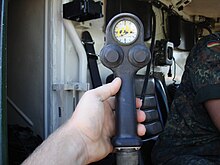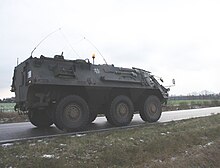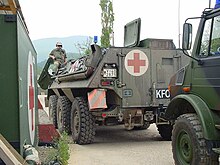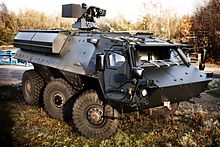Fox (tank)
| Transport tank 1 "Fuchs" | |
|---|---|
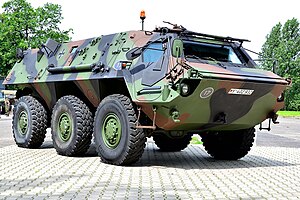
Transport tank Fuchs of the Bundeswehr (2012) |
|
| General properties | |
| crew | 2 (driver, commander) + 8 infantrymen (depending on the installation and conversion kit) |
| length | 6.83 m (standard) 6.88 m (MSA) 7.11 m (EloKa) 7.17 m (radio) 7.30 m (ABC) |
| width | 2.98 m 3.04 m (MSA) |
| height | 2.30 m (without antennas) 2.37 m (ABC) |
| Dimensions | 16.5 t (EloKa) 17 t (standard, radio and ABC) 19 t (MSA) |
| Armor and armament | |
| Armor | Armored steel adapted composite armor (MSA) |
| Main armament | up to three 7.62 mm MG3s or two 7.62 mm MG3s and one MILAN anti-tank guided missile |
| Secondary armament | no |
| agility | |
| drive | Mercedes-Benz 8-cylinder diesel engine type OM 402A with exhaust gas turbocharger , 12,763 cm³ Mercedes-Benz 6-cylinder diesel engine type OM 501LA with exhaust gas turbocharger and charge air cooler , 11,946 cm³ (MSA) OM 402A: 235 kW (320 PS) OM 501LA: 315 kW (428 PS) |
| suspension | hydraulic shock absorbers, coil springs |
| Top speed | 96 km / h (road) 10 km / h (water with propeller) |
| Power / weight | 13.8 kW / t 14.2 kW / t (EloKa) 16.6 kW / t (MSA) |
| Range | 800 km (road) 400+ km (terrain) |
The Fuchs Transportpanzer (TPz Fuchs) is an amphibious wheeled armored vehicle from German production. In addition to its main area of responsibility as a transport tank and armament carrier , the six- wheel , all-wheel drive vehicle served as the basis for the Wildcat anti-aircraft tank and as a weapon carrier for various weapon systems in the test phase. In addition to the various vehicle variants, a basic distinction is made between the Fuchs 1 and the further development of the Fuchs 2. It was manufactured by the former arms company Thyssen - Henschel , which has belonged to Rheinmetall Landsysteme since 1999 and is a subsidiary of Rheinmetall AG.
development
Development of the Fuchs began in 1961 and was part of the planned second generation of all-terrain armored wheeled vehicles for the German Bundeswehr . In 1962, Daimler-Benz received the order to test the concept. In 1964 the study with the six prototypes with a combat weight between 7 and 10 tons ( Unimog SH, T ) and the vehicle developed by the Swiss company Mowag for swimming operation was completed.
In the same year a new concept followed with new requirements, according to the NATO standard, divided into the service classes 0.5, 2, 4, 7 and 10 tons (t). In order to be able to continue realizing the project, the Bundeswehr attempted to win the vehicle manufacturers over to work together. Through the Association of German Automobile Manufacturers , the companies Henschel , Büssing , KHD , Krupp and MAN were successfully signed. Daimler-Benz took part in the tender in 1966 as a competitor.
In 1968 the two applicants presented their prototypes . A year later, the Bundeswehr changed its requirements from 1964 again and only required an armored all-terrain and buoyant transporter with NBC protection , a minimum payload of two tons and a total payload of four tons.
The project was further developed in the following years. With its version, Daimler-Benz received the order for the further development of the transport vehicle (6 × 6) and the Spähpanzer 2 "Luchs" for the replacement of the Spähpanzer Hotchkiss 11-2 and M41 . In 1973 one concentrated on the further development of the armored personnel carrier and recognized the universal application possibilities. Ten Transportpanzer 1 were delivered to the Federal Office for Defense Technology and Procurement (BWB) for troop trials. A study on the Transportpanzer 2 (4 × 4) and light Spähpanzer 3 (4 × 4) was dropped in 1979 with the series production of the Transportpanzer 1 by Thyssen - Henschel in Kassel as general contractor.
The amphibious pioneer reconnaissance vehicle (APE) based on the Transportpanzer 2 study can be viewed today in the Defense Technical Study Collection in Koblenz . A model with a 20 mm on- board machine gun did not reach series production either.
By 1993, 1,031 vehicles had been delivered to the Bundeswehr and replaced the SPz Hotchkiss and M113 in some of their functions.
technology
The Fuchs 1 is an armored wheeled tank with all-wheel drive and floating drive. It is used in most branches of the German Army and, thanks to its installation and upgrade kits, is an all-rounder in the German Armed Forces for the transport of material and people on the battlefield. In addition, some of the armored transport vehicles are also used as referee vehicles in the army's combat training center.
construction
The vehicle consists of a self-supporting welded armored hull and armored glass with bulletproof shields. It is partially partitioned and offers the crew limited protection against handguns and fragments. The tub is divided into driver, engine and transport area . The driver's area is connected to the transport area by a crawl tunnel that leads past the engine room on the right. To protect against NBC weapons , all versions have an NBC protective ventilation system with an output of three cubic meters per minute. For night drives, the driver has a residual light amplifier vehicle that can be used instead of the corner mirror . In swimming mode, the tank is powered by two propellers. The surge shield required for water travel can be opened hydraulically.
Drive and chassis
The Fuchs is powered by an 8-cylinder diesel engine (type: OM 402A) from the OM-400 series from Mercedes-Benz without additional armor. Arranged in a V-shape and equipped with two exhaust gas turbochargers, the engine produces 235 kW (320 hp) at 2500 rpm with a displacement of 12,763 cm³. The top speed is 96 kilometers per hour (km / h) and can be briefly increased to 130 km / h. The minimum speed is four km / h. Its permanent all-wheel drive in conjunction with its chassis give it a high degree of mobility and driving safety off-road and on the road. Its two steering axles allow it a turning circle of 17 meters. The chassis offers a ground clearance of 40 cm. During the swimming operation, the commander takes control from the passenger hatch and operates the two rudder propellers of the Fuchs via a kind of joystick, the so-called "swim handle", which enables the propellers to pivot 360 °. The rudder propellers are driven by a propeller shaft intermediate bearing of the drive distributor. The speed of the counter-rotating propellers is proportional to the engine speed and is controlled by the driver. The swimming drive enables the fox to swim at a speed of up to 10 km / h.
Armament
The armament of the fox is primarily intended for self-defense. The variants of the Bundeswehr have a maximum of three MG3 machine guns on free-aiming mounts. This variant is only used for troop transports. The first machine gun is mounted on the rotating ring mount of the passenger hatch, another on the rear combat hatch and, in exceptional cases, one on the commanders hatch in the middle of the vehicle. However, due to the theoretical directional range of 360 °, this option is rarely used.
Only two MG3s are provided for troop transporters with the MILAN anti-tank weapon . The MILAN launch system will be installed in the commander's hatch and will enable the infantry to fight armored vehicles. All other variants, with the exception of the ambulance vehicles, have at least one MG3 on the passenger hatch.
For self-protection, the crew of the Fuchs has a smoke-throwing system with six throwing cups at their disposal, in order to be able to hide the vehicle from the view of the attacker with smoke or smoke grenades.
Since the deployment in Somalia in 1993, work has been carried out on an additional armored fox with a 20-millimeter cannon for the units of the crisis reaction forces. Equipped with a turret from Keller und Knappich Augsburg ( KUKA ) Wehrtechnik, now also part of Rheinmetall, and the Rh 202 from Rheinmetall, the Fuchs-KRK had almost the same firepower as the Marder armored personnel carrier and was supposed to take over the task of escorting the convoy. The project was discontinued in 1999 due to technical difficulties and serious deficiencies.
Once approved, the 1A8 will carry the remotely controllable weapon station FLW 200 from KMW.
Electronic protection
With the deployment in Bosnia and Afghanistan, the threat posed by anti-tank mines and IEDs came to the fore. Various jammers have been integrated to protect against IED. The systems, known as “Jammer” or “Counter-IED”, serve as protection against remotely detonable explosive devices . The first generation was the CG-10 system with control unit, three different antennas and the jamming transmitters, which superimpose other signals with interference radiation on the frequencies of VHF, UHF and GSM. Another device, the Cassidian CG-12 system, forms a kind of electromagnetic bell around the vehicle and complements the CG-10. Then there is the CG-20 + system, which has seven antennas on the frequencies of HF, VHF, UHF and GSM up to 6000 MHz.
Variants, equipment, conversion kits
The Fuchs armored personnel carrier can be adapted to the respective application with various installation kits (EBS) or conversion kits (RS). The different basic versions (standard, radio, EloKa) and the various installation and conversion kits result in more than 90 possible combination options.
Combat value increases
Since its introduction by the German Armed Forces, the fox has been upgraded several times (KWS). In addition to the overhaul of the vehicles and the preservation of materials, the various foxes have been upgraded. The first transport tanks were equipped with a SEM 25/35 radio and were equipped with the more powerful SEM 80/90 radio family from the conversion to the 1A4. Other vehicles also received the crypto and SATCOM capable SEM 93 and are listed as 1A6. In an extensive KWS for the 1A7 type, some variants of the Fuchs received additional armor, among other things. As part of the introduction of TPz 1A8 in 2008, other armored vehicles of this type were also brought up to the current state of the art, in addition to further armoring for selected vehicles. So the sets obtained leading vehicle, vehicle group pioneers group reconnaissance vehicle tanks and mobile medical vehicle, the command and information system OWN (guide equipment, tactical) to NEC and integration into the existing system FüInfoSys German Army. In addition, some of the armored transport vehicles were equipped with a jamming transmitter (CG20) in 2008 .
The variants used in the Bundeswehr are:
TPz 1 standard
The standard version or the basic model serves as a crew transport vehicle. The basic model can be supplemented with the following installation and conversion kits. The rates determine the arrangement of the equipment in and on the vehicle as well as the vehicle armament. Externally, the basic model can be recognized by the smooth rear doors, as it does not have a power generator (SEA) and the exhaust muffler for the SEA 15 kW is missing on the left side of the vehicle.
EBS tank reconnaissance group / Jägergruppe with anti-tank weapon MILAN (KWS to TPz 1A4)
With this installation kit, the Fuchs is used as a personnel carrier by the tank grenadiers , mountain troops , hunters , tank reconnaissance and the Franco-German brigade . It includes eight seats, brackets for weapons and equipment for soldiers and preparation for the MILAN weapon system .
EBS infantry group vehicle (KWS to TPz 1A4)
This installation kit corresponds to the EBS Panzer Reconnaissance Group / Jägergruppe , but without MILAN preparation.
EBS group vehicle pioneers (KWS to TPz 1A4)
The EBS group vehicle pioneers changes the fighting area of the fox to accommodate a tank pioneer group including equipment and weapons. The Pi-Fuchs has all the necessary mounts for the equipment and weapons of the pioneers. Externally, this variant can be recognized by the two distinctive containers for holding the S-wire rolls on the roof and the additional bulwark on the vehicle.
EBS command and radio vehicle with and without 5 kW generator set
With this EBS, the basic model becomes a command vehicle. The vehicle has three folding seats , a folding table, a map board and, in some cases, a portable generator set. Externally, these vehicles can be recognized by the crank mast for the aerial on the right-hand side of the vehicle, several FA-80 vehicle antennas and the brackets for the cable reels on the roof.
EBS pioneer leadership vehicle
The equipment of the pioneer command vehicle is the same as that of the EBS command and radio vehicle, with the difference that a safe for blocked documents and other documents classified as secret was installed in the interior. The armored transport known as PiFü-Fuchs is used by the pioneer units as a pioneer explorer at division level and as a command vehicle for the company commander and platoon leader at brigade level.
EBS medical group with room cooling system (KWS to TPz 1A4 / A4A1)
With the EBS, the Fuchs is equipped to an armored ambulance (KrKw). It can be used to transport up to four lying or two lying and four seated wounded as well as a medical soldier for care. The brackets correspond to the NATO standard, which enables the inclusion of corresponding equipment from other armies. According to the Geneva Convention, the vehicle is unarmed.
RS radio squad brigade commander with HF device 400 watts
The upgrade kit supplements the Fuchs-FüFu and is used by the tank reconnaissance troops. It differs only through an additional antenna, the additional HF radio device and a large pull-out power generator in the interior.
TPz 1A1A5 "Hummel"
As early as the beginning of the project planning for the Fuchs in the 1970s, the German Armed Forces demanded that a variant of the new transport tank for the EloKa telecommunications force should be able to carry an upgrade kit for electronic warfare and reconnaissance . Outwardly, the bumblebee differs from the standard variant by the missing surge shield, the pulled-down wheel arches in the rear area, the missing propellers, the power generation unit on the left rear door and the antenna forest (multiple antenna system directional antenna LPU with twelve rod antennas of different lengths) on the roof. The EK 33 jammer kit is installed in the cabin , which interferes with automatic multi-channel jamming operation . The bumblebee's jammer works in multi-channel operation and is used against voice and data connections. The frequency is 20 to 80 MHz in the VHF range and 100 to 500 MHz in the UHF range. In order to operate this, the installation of the SEA 15 kW generator was necessary. In 2000 the vehicles were retrofitted with Cassidian SGS-2000 jammers. Since 2007 an increase in combat value (KWS-RMB) with an improved antenna system has been carried out. These vehicles are called Hummel 0506 and are also equipped with a VHF cluster interference antenna, UHF discone receiving antenna and a GSM interference antenna (900/1800 MHz). This kit also includes a retractable VHF-LPD interference antenna for the frequency range between 80 and 500 MHz at the rear. A 2000-watt HF power amplifier and two additional SEM80 / 90 VHF radios have also been retrofitted inside.
TPz 1A1 EloKa "Peiler"
This fox, like the bumblebee, can be recognized externally by the missing surge shield , the pulled-down wheel arches in the rear area, the missing propellers and the retractable beacon antenna. The HF / VHF reconnaissance device is used to locate transmitters. The "Peiler" has a mast system that can be extended to twelve meters on the vehicle roof. The system developed by EADS enables troop radio to be received in the frequency range from ten kilohertz (kHz) to 40 gigahertz. Since 2007, the Bundeswehr has had a direction finder (KWS-RMB) with improved combat value and an improved antenna system.
TPz 1A2 / A5 radio

The basic radio version of the tank transport was equipped with special radio equipment kits. Some of the variants have a 5 kW generator set (SEA) in the left rear door or a room cooling system. With the introduction of the SEM 80/90 radios, the variants are named TPz Fuchs 1A5 . Externally, these variants can be recognized by the box-shaped attachment instead of the left rear door and the missing muffler for the SEA 15 kilowatts (kW) on the left side of the vehicle.
EBS command and radio vehicle FüFu with 5 kW SEA
This variant is used to lead your own troops. In contrast to the FüFu of the basic model, this variant has a permanently installed power generator in the left rear door to ensure the increased power consumption of the radio and transmitter system when the vehicle is stationary. In addition, it is equipped with a crank mast for the aerial and has folding tables, several radios (at least three) and a map board in the interior.
RS PARA RASIT, tank reconnaissance radar with 5 kW SEA

The Fuchs with the armored reconnaissance radar, RASIT kit is used by the armored reconnaissance troops (part of the army reconnaissance troops since 2007 ). It serves the scouting teams as support in clearing up the battlefield during the day, at night and when visibility is restricted. For this purpose, the PARA fox, known in the military jargon, has the French reconnaissance radar DR PT 2a RASIT ( Radar d'Acquisition et de Surveillance Intermédiaire ), which can be used on and off. Installed in the center of the vehicle, the radar antenna can be extended up to 1.80 meters above the top edge of the vehicle by means of three spindle drives and thus enables individual people to be scouted at distances of up to 6000 meters, groups of people up to 8000 meters and vehicles and helicopters at distances up to 20,000 meters. The vehicle also has a vehicle navigation system and a destination route recorder with which destinations and their routes are entered on a map.
Before the RASIT system was introduced, the TPS 33a battlefield radar served as an interim solution. The system was able to enlighten individual persons at a distance of 1500 meters, whereby vehicles could be detected at a distance of up to 18,000 meters.
RS command and radio vehicle for air defense command (FüFuFlaFü), without 5 kW SEA
The FlaFü Fuchs is based on the basic model of the transport tank and, in addition to the FüFu installation kit, has the additional anti-aircraft command kit (FlaFü) for the army anti-aircraft reconnaissance and combat command system ( HFlaAFüSys ). The vehicle was used by the Army anti-aircraft troops and is used to guide the cheetah . Until its dissolution, the anti-aircraft regiments of the corps equipped with Roland were also run with it. The FlaFü upgrade kit complements the equipment with brackets for additional radios, fire control instruments and antennas. Externally, these vehicles can be recognized by the rectangular roof boxes and the SEA-like storage box on the left rear door.
TPz 1A3 / A6 (ABC tracer)


The first ABC tracer tanks delivered in February 1988 (referred to as “Tracker” in military jargon) are based on TPz 1A3 (standard) with SEM 25/35 and are able to detect radioactive and chemical contamination directly on site. The detection of biological weapons is not possible and is limited to the sampling.
The detection equipment was integrated as an upgrade kit and enabled sampling, analysis and marking under full ABC protection. In addition to a Geiger counter, the heart of the detection equipment is the MM-1 detection device, a miniaturized mass spectrometer combined with a gas chromatograph . In use, up to 22 pollutants can be continuously detected next to one another, with warfare agents up to a concentration of less than a billionth of a gram (nanogram) being detectable in 30 seconds. The mass spectrometer is produced by Bruker Daltonics in Leipzig .
The Tracker has three modes of operation for collecting samples. When detecting air , the terrain can be driven quickly, while outside air is sucked in and fed to the analysis device. A much slower option is to feel the ground . Two ground-tracking wheels on the rear of the vehicle pick up possible warfare agents and are alternately guided to a probe. For a more precise check, the crew uses point sensing , in which the extendable probe is used at the rear of the vehicle.
With the conversion to the SEM 80/90 in 1993/1994, some NBC armored vehicles were subjected to an increase in performance. The vehicles designated as A6 ABC received a navigation system, while the vehicles designated as A6A1 ABC (KWS) received a sensor mast, the SEM 90/93 and GPS . In addition, sampling and storage for B samples have been improved.
In 1994 Thyssen-Henschel planned a mobile bio-laboratory to enable the detection of biological warfare agents. The laboratory, known as BIRD ( Biological Identification Refinement Device ), was housed in a special cabin and loaded onto the Bundeswehr's standard two-wheeled trailer. The tank was supposed to serve as the towing vehicle. Since 2002, Rheinmetall Landsysteme has been promoting the organic tracer, which is under development, on its website . He is supposed to close the capability gap and be able to detect biological warfare agents by genetic as well as immunological methods.
TPz 1A7
The armored transport vehicles designated as 1A7 were additionally armored with modular protective equipment (MSA) and are equipped with the SEM 80/90 radio family and some with room cooling systems. A total of 124 vehicles received this conversion. They are mainly to be found in the Bundeswehr missions abroad.
The protective equipment consists of the adapted additional armor type MEXAS on the outer surfaces, a splinter protection in the interior (the so-called Spall-Liner) and an extended mine protection in the floor area of the vehicle. The mount protection (not for ambulance vehicles) is not part of the protective equipment, but can be mounted on every Fuchs as an upgrade kit. The vehicles were also equipped with a more powerful 6-cylinder engine from Mercedes-Benz. These conversions made the vehicles around three tons heavier and exceeded the permitted vehicle width. All additional armored vehicles were also blocked for swimming.
From July 2003 to the end of 2006, Rheinmetall Landsysteme modified the Fuchs 1A7 armored personnel carriers again. This was necessary because the increased total weight of some variants threatened to end their road approval. As part of this change package 1 , all vehicles received chassis reinforcements, electrohydraulic door actuation devices, a room cooling system and additional anti-mine protection plates in the middle and rear wheel arches. The float drive and the surge shield, however, were removed, whereby the transport armored vehicles 1A7 finally lost their buoyancy. These measures made it possible to lift the existing operational restrictions and also to create a payload reserve.
The conversion to the MSA-Fuchs extended to the following variants:
- EBS tank reconnaissance group / hunter group with anti-tank weapon MILAN
- EBS group vehicle pioneers
- EBS pioneer leadership vehicle
- EBS medical group with room cooling system
- Data processing, United Nations command support, mobile command post (UN equipment)
TPz 1A8
On 20 March 2008, the army received the first of 21 vehicles (five ambulances, two guide and radio vehicles, three pioneering vehicles and eleven group vehicles) with an improved protection against mines and improvised explosive devices (Engl. Improvised Explosive Devices (IED) ). The vehicles procured as "Deployment-related Immediate Requirement (ESB)" were delivered by June 2008.
The main changes compared to variant 1A7 include structural changes to the tubs in the floor area through additional anti-mine protection plates and intermediate floors, decoupling of the seats from the floor, reinforcements in the wheel arches with armored steel molded parts, further door reinforcements, changed window mountings in the doors and additional storage space as well as reinforcements in the outside area .
On July 9, 2010, Rheinmetall Defense and the BWB agreed in a contract to convert a further 65 Fuchs trucks to the A8 armament stand. At this point in time, 61 Fuchs TpZ had already been upgraded to this set-up, so that from 2012 a total of 126 Fuchs A8s were in stock. They are based on conversions of the Fuchs A7.
On April 19, 2013, the Vice President of the Federal Office for Equipment, Information Technology and Use of the Federal Armed Forces (BAAINBw) and Rheinmetall MAN Military Vehicles signed the contract to improve the protection of 25 other transport tanks. This means that by the beginning of 2016 a total of 162 transport tanks of the 1A8 type in 16 variants will be available for use by the troops.
In December 2016, Rheinmetall received a follow-up order for the retrofitting of a further 90 vehicles, which are to be delivered from 2017, increasing the number of 1A8 Fuchs variants to 267 by the end of 2020.
The 1A8 variants are:
- TPz 1 A8A1 DVFü (remote data transmission)
- TPz 1 A8A2 SanBAT ( mobile medical team )
- TPz 1 A8A3 PzAufKlGrp (EBS Panzer Reconnaissance Group)
- TPz 1 A8A3A1 PzAufKlGrp with FLW 200
- TPz 1 A8A4 PiGrp (EBS group vehicle pioneers)
- TPz 1 A8A5 FüFu EOD (command and radio vehicle disposal of ordnance)
- TPz 1 A8A6 PARA (PARA RASIT, tank reconnaissance radar)
- TPz 1 A8A7 ABC (ABC armored vehicle)
- TPz 1 A8A8 KpfmRTrp (ordnance clearance team)
- TPz 1 A8A9 JFSCT ( Joint Fire Support Coordination Team )
- TPz 1 A8A10 KpfmBesTrp (ordnance disposal squad)
- TPz 1 A8A11 BrdSchtzTrp (fire protection team)
- TPz 1 A8A12 GRCP (German Route Clearance Package, operator vehicle)
- TPz 1 A8A13 KAI (ordnance reconnaissance and identification with manipulator arm to verify and grasp suspicious objects / ordnance)
- TPz 1 A8A14 Command and Fire Control Center Armed Forces Joint Tactical Fire Support
- TPz 1 A8A15 Weather group (meteorological data determination and evaluation) Armed forces joint tactical fire support
- TPz 1 A8A16 radio group with high frequency radio of the HRM-7400 series
- TPz 1 A8A17 jammer CG20 +
Use and export

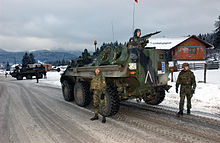
The ABC-Spürpanzer ("Tracing Fox") proved to be an export hit. It was sold to the United States (Fox NBCRS, later M93A1), the United Kingdom , the Netherlands ( Koninklijke Landmacht ), Turkey , Saudi Arabia ( armed forces ), Kuwait ( armed forces ), Israel and Venezuela . Two further vehicles from the armed forces' stocks were leased to Norway for four years from 2004 . Norway intended to buy a total of six vehicles, which were manufactured by Rheinmetall in 2010 in the expansion stage of the 1A8.
In 1991, 36 used NBC tracer tanks were sold to Saudi Arabia for a price ten times the original price. Since the then manufacturer of the vehicles, Thyssen Industrie Henschel AG, ran into delivery problems, those responsible for the army were urged by the Ministry of Defense to provide the vehicles from the Bundeswehr's inventory. The sale was organized by the arms dealer Karlheinz Schreiber , who paid bribes to employees of the Ministry of Defense to speed up exports. The Defense State Secretary Ludwig-Holger Pfahls ( CSU ), who was responsible for exports at the time, was sentenced to two and a quarter years in prison in 2005 after five years of flight for taking advantage and tax evasion . The events surrounding this export form an episode in the CDU donation affair and also resulted in a restriction of the Bundeswehr's NBC defense capability, as the vehicles sold were no longer available to their own troops and could not be replaced promptly due to the manufacturer's delivery bottlenecks . After the change of government in 1998 it was found that files on the export to Saudi Arabia were missing in the Federal Chancellery (“ federal deletion days ”).
In autumn 2004 it became known that 20 Fuchs armored personnel carriers were to be delivered to Iraq from the stocks of the Bundeswehr . Germany wanted to support the reconstruction with the vehicles, but the project was not implemented. Government spokesman Béla Anda told Handelsblatt in 2005: “This is obviously because there is no longer any need on the part of the Iraqis.” The delivery did not fail on the German side: “Germany would have been willing to continue to deliver the 'foxes' deliver."
In 2011 the German government approved the sale of 54 armored transport vehicles worth 195 million euros to Algeria . In addition, a Rheinmetall subsidiary in Algeria plans to manufacture a total of 980 Fuchs 2 tanks worth 2.7 billion euros.
Experience in Afghanistan
In Afghanistan, the TPz Fuchs has repeatedly been the target of attacks and attacks. On November 16, 2008, one soldier was seriously wounded and another was slightly wounded in an IED explosion between Kunduz and Mazar-e Sharif . The Fuchs (conversion kit CG20) was a vehicle from the EloKaBtl 932 from Frankenberg in Hesse.
On April 29, 2009, a German soldier was killed when a patrol was ambushed near Kunduz and a fox (installation kit Jägergruppe) was hit by an RPG anti-tank weapon . The soldier from Jäger Battalion 292 was at the rear machine gun in this incident. Four other soldiers were wounded.
On June 23, 2009, three German soldiers were killed in combat operations near Kunduz when their vehicle was shot at with small arms and bazookas . It is assumed that the crew may have drowned or fatally injured when they fell into a ditch with the vehicle. Radical Islamic Taliban claimed responsibility for the attack.
outlook
The TPz Fuchs has been replaced by the GTK Boxer in the variant EBS group vehicle, infantry and EBS command and radio vehicle since 2009 . As a version (Para) with the Rasit tank reconnaissance radar, the Fuchs was to be replaced by the ATF Dingo with the new BÜR radar system, but this was not introduced. Due to its reliability and popularity with the troops as well as the lack of alternatives for certain variants, the last vehicles will remain in use beyond 2025 according to current planning.
Fox 2
The Fuchs 2 is a further development from Rheinmetall Landsysteme. Outwardly it is similar to the Fuchs 1, but it has undergone some performance improvements. It has an increased payload from four to eight tons, a Euro III diesel engine from MTU with 315 kW (428 hp), an ergonomically improved fighting compartment, a digital electrical system, a tire pressure control system and an improved braking system. The armoring can be adapted to the protection concept required in each case by means of a modular design.
In October 2007 the US Army signed a contract to upgrade 18 of its 123 Fuchs-1 tanks. The upgrade of 37 vehicles to Fuchs 2 was also planned for the Bundeswehr. The project was not implemented in favor of the combat value enhancement program for Transportpanzers 1.
Another user is the United Arab Emirates . After an international comparison, the federation decided in February 2005 to purchase 32 vehicles. By 2009, Rheinmetall delivered 16 armored vehicles for nuclear and chemical warfare agents, eight armored vehicles for biological warfare agents and eight Fuchs 2 as a mobile command post. The total cost was 160 million euros and includes training support and technical assistance.
See also
literature
- Lutz-Reiner Gau, Jürgen Plate, Jörg Siegert : German military vehicles: Bundeswehr and NVA. Motorbuch, Stuttgart 2001, ISBN 3-613-02152-8 .
- Jochen Vollert: Fuchs - The transport tank TPz-1 of the Bundeswehr. Development - Variants - Technology - Use. Tankograd Publishing, Trogen 2002, ISBN 3-936519-00-5 .
Web links
- TPz Fuchs at the manufacturer Rheinmetall
- TPz Fuchs at waffenHQ.de
- 60 seconds Bundeswehr: Armored Transport Fuchs ( YouTube video, May 2, 2018)
- Bundeswehr Classix: Fuchs on Wheels - The Bundeswehr's first transport tank (1980) (YouTube video)
- Bundeswehr Classix: Fuchs clears up (1990) (ABC-Spürpanzer version, YouTube video)
Individual evidence
- ^ KRK Fuchs: German Bundestag: Plenary Protocol 14/52, Annex 6; Inquiry from Werner Siemann CDU / CSU to the BMVg. [pdf]
- ↑ Ernst-Reinhard Beck, CDU Bundeswehr leadership responded appropriately to the problem of the booby traps
- ↑ a b Rheinmetall Defense: Modernized fox with comprehensive protection against mines and IED ( memento from January 1, 2009 in the Internet Archive ) as of October 31, 2008
- ↑ Technical University of Hamburg-Harburg : Prof. Dr.-Ing. Gerhard Matz retired Environmental measurement technology ( page no longer available , search in web archives ) Info: The link was automatically marked as defective. Please check the link according to the instructions and then remove this notice.
- ↑ bits.de: Alexander Richter; Keyword: Fuchs armored vehicles . [As of May 21, 2008]
- ↑ Answer of the Federal Government of December 19, 2006 to a small question u. a. of the FDP parliamentary group in the Bundestag. Retrieved April 9, 2009
- ↑ Defense Professionals: Fox Reloaded - When a look back is a step forward. ( Memento from September 21, 2011 in the Internet Archive )
- ↑ Federal Office for Defense Technology and Procurement: First FUCHS transport tank with improved mine and IED protection handed over to the troops. [As of May 21, 2008]
- ↑ Page no longer available , search in web archives: TpZ Fuchs on BW org.
- ↑ Another contract to improve the protection of the transport tank 1 FUCHS signed. Federal Office for Equipment, Information Technology and Use of the Bundeswehr, April 25, 2013, accessed on May 3, 2013 .
- ↑ Bundeswehr receives further highly protected Fuchs 1A8 vehicles from Rheinmetall - order value € 36 million ( Memento from July 1, 2013 in the web archive archive.today )
- ↑ Rheinmetall receives a major order from the German armed forces for highly protected Fuchs tanks worth EUR 135 million
- ^ Dorothee Frank: Fuchs KAI delivered to the Bundeswehr. In: ESUT - European Security & Technology. May 8, 2020, accessed on May 9, 2020 (German).
- ↑ rheinmetall-defence.com Future- oriented ABC education - Fox ABC detection system, organic detection fox ( memento from November 28, 2010 in the Internet Archive ), ... As a variant with maximum self-protection, the ABC-Fuchs 1A8 is currently for the Norwegian armed forces manufactured ...; Retrieved November 28, 2010
- ↑ Rheinmetall Defense six sniffers for the Netherlands ( Memento from December 7, 2007 in the Internet Archive ); ... other systems are u. a. in use in Germany, Norway, Great Britain and Saudi Arabia ... , accessed October 30, 2010
- ↑ Forsvarsnett: beskytter mot Kjemiske våpen. Norwegian Armed Forces, April 20, 2004, archived from the original on May 15, 2004 ; Retrieved September 19, 2018 (Norwegian). Article on the website of the Norwegian Army about the acquisition of the Fuchs armored vehicle
- ↑ Alexander Richter: Keyword: Fuchs Spürpanzer. Berlin Information Center for Transatlantic Security, 2002. online
- ↑ handelsblatt.com: Germany does not deliver "Fuchs" tanks to Iraq [4. February 2005]
- ↑ Arms shops Algeria wants to build German tanks. Spiegel Online, accessed November 11, 2012 .
- ^ Factory for German Fuchs tanks - Rheinmetall equips Algeria. n-tv.de, accessed on June 19, 2014 .
- ^ Soldiersglueck.de: Afghanistan: Another booby-trap attack against the Bundeswehr near Kunduz, no soldier wounded, a FUCHS slightly damaged.
- ↑ BMVg press release: Page no longer available , search in web archives: Attack on German patrol.
- ^ Soldiersglueck.de: Breaking news: Another attack on the Bundeswehr in Afghanistan, four soldiers slightly wounded.
- ↑ http://www.bmvg.de/portal/a/bmvg/sicherheitspektiven/einsaetze/isaf?yw_contentURL=/C1256F1200608B1B/W27RLCE5057INFODE/content.jsp
- ↑ Welt.de: Three German soldiers killed in a firefight.
- ↑ http://www.army-technology.com/projects/fuchs/
- ↑ Jane's Defense Weekly: UAE prepares to receive first Fuchs 2 NBC RS. Retrieved April 20, 2010


